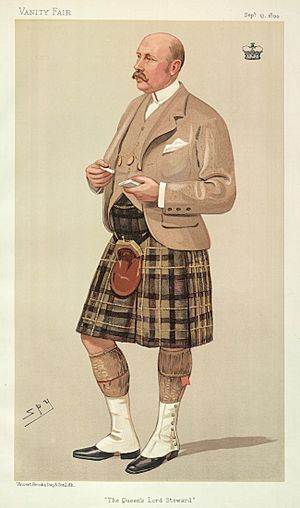Gavin Campbell, 1st Marquess of Breadalbane facts for kids
Quick facts for kids
The Most Honourable
The Marquess of Breadalbane
|
|
|---|---|

"The Queen's Lord Steward". Caricature by Spy published in Vanity Fair in 1894.
|
|
| Lord Steward of the Household | |
| In office 25 August 1892 – 21 June 1895 |
|
| Monarch | Victoria |
| Prime Minister | William Ewart Gladstone The Earl of Rosebery |
| Preceded by | The Earl of Mount Edgcumbe |
| Succeeded by | The Earl of Pembroke |
| Personal details | |
| Born | 9 April 1851 Fermoy, County Cork, Ireland |
| Died | 19 October 1922 (aged 71) Glasgow, Scotland |
| Nationality | British |
| Political party | Liberal |
| Spouse | Lady Alma Graham (1854–1932) |
| Alma mater | University of St Andrews |
Gavin Campbell, 1st Marquess of Breadalbane (born April 9, 1851 – died October 19, 1922) was a Scottish nobleman and a Liberal politician. He held several important roles in the British government. He was known by different titles during his life, including Lord Glenorchy and the Earl of Breadalbane and Holland, before becoming the Marquess of Breadalbane.
Contents
Early Life and Education
Gavin Campbell was born in Fermoy, County Cork, which is in Ireland. He was the oldest son of John Campbell, the 6th Earl of Breadalbane and Holland, and Mary Theresa. He went to St Andrews University for his education.
When his father became the Earl of Breadalbane and Holland in 1862, Gavin Campbell received the courtesy title of Lord Glenorchy. This is a title used by the children of nobles. He became the Earl of Breadalbane and Holland himself in 1871 after his father passed away.
Military Service
Gavin Campbell also had a military career. From 1873 to 1874, he was a lieutenant in the 4th Battalion of the Argyll and Sutherland Highlanders. Later, he joined the Shropshire Yeomanry, which was a type of cavalry unit. He started as a Sub-Lieutenant in 1877 and retired as a captain in 1887.
From 1897 to 1910, he was a Lieutenant-Colonel leading the Highland Cyclist Battalion. In 1913, he became their Honorary Colonel. In 1903, he was also appointed an Aide-de-Camp (a personal assistant) to King Edward VII.
A Seat in Parliament
Because his earldom was a Scottish title, it did not automatically give him a seat in the House of Lords in the British Parliament. To fix this, in 1873, he was given a new title, Baron Breadalbane, which was a Peerage of the United Kingdom. This new title allowed him to take a seat in the House of Lords.
In the same year, he was appointed a Lord-in-waiting in the Liberal government led by William Ewart Gladstone. A Lord-in-waiting is an official who helps the monarch.
Important Government Roles
The Liberal government lost power in 1874, but they returned to office in 1880. At that time, Gavin Campbell was made a member of the Privy Council. This is a group of advisors to the King or Queen. He was also appointed Treasurer of the Household by Prime Minister Gladstone, a role he held until 1885. The Treasurer of the Household manages the royal household's finances.
In 1885, he received even higher titles. He was made Earl of Ormelie and Marquess of Breadalbane in the Peerage of the United Kingdom.
Lord Breadalbane did not serve in Gladstone's short government in 1886. However, he held office again as Lord Steward of the Household from 1892 to 1895. The Lord Steward is a very senior official in the royal household. He served under Prime Minister Gladstone and then under Prime Minister Lord Rosebery.
Special Honors and Duties
In 1894, Gavin Campbell was appointed a Knight of the Garter. This is one of the highest and most prestigious honors in the United Kingdom.
He also served as Lord High Commissioner to the General Assembly of the Church of Scotland in 1893, 1894, and 1895. In this role, he represented the King or Queen at the annual meeting of the Church of Scotland. From 1914 until his death in 1922, he was the Lord Lieutenant of Argyllshire. This meant he was the King's personal representative in that area of Scotland.
He was also the last person to hold an old Scottish role called the Keeper of the Privy Seal of Scotland. He held this position from 1907 until he passed away in 1922.
Lord Breadalbane received honors from other countries too. He was a Knight of the Order of the Seraphim from Sweden. He was also a Knight of Justice of the Order of St John of Jerusalem. In this role, he represented King Edward VII during a special ceremony in 1902 at Marienburg Castle in Poland. He also received a silver medal from the Royal Humane Society for saving lives. He was a Brigadier-General of the Royal Company of Archers, which is the King's bodyguard in Scotland.
Family Life
Lord Breadalbane married Lady Alma Imogen Carlotta Leonore Graham in 1872. She was the youngest daughter of James Graham, 4th Duke of Montrose. They did not have any children.
He passed away in Glasgow, Scotland, in October 1922, at the age of 71. He was buried at Finlarig. When he died, his titles of Baron Breadalbane, Earl of Ormelie, and Marquess of Breadalbane ended because he had no children. However, his Scottish titles were passed on to his nephew, Iain. Lady Breadalbane passed away in May 1932.

